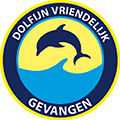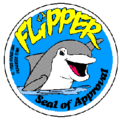Dolphin safe label
The concept of dolphin-safe tuna labeling originates in the United States.[1] The labels have become increasingly controversial since their introduction, particularly among sustainability groups in the U.S. Various dolphin-safe labels are used to denote compliance with various laws or policies designed to minimize dolphin fatalities during fishing for tuna destined for canning. Some labels impose stricter requirements than others.
According to the U.S. Consumers Union, these labels provide no guarantee that dolphins are not harmed during the fishing process because verification is neither universal nor independent. Still, tuna fishing boats and canneries operating under any of the various U.S. labeling standards are subject to surprise inspection and observation.[2]
Background
Dolphins are a common by-catch in tuna fisheries, especially in the Eastern Tropical Pacific Ocean, as they commonly swim with schools of yellowfin tuna. The dolphins, who swim closer to the surface than tuna, may be used as an indicator of tuna presence. Labeling was originally intended to discourage fishing boats from netting dolphins with tuna.
Dolphins do not associate with Skipjack tuna and this species is most likely to be truly "dolphin safe".[2] However, the species of tuna is not always mentioned on the can.
Criticism
Definition
In a 2008 report, Greenpeace notes dolphin-safe labels may make consumers believe the relevant tuna is environmentally friendly. However, the dolphin-safe label only indicates the by-catch contained no dolphins. It does not specify that the by-catch contained no other species, nor does it imply anything about the environmental impact of the hunt itself.[3]
In May of 2012, the World Trade Organization ruled that the dolphin safe label, as used in the U.S., focuses too narrowly on fishing methods, and too narrowly on the Eastern Tropical Pacific.[4] The U.S. label does not address dolphin mortalities in other parts of the world.
In 2013, the Campaign for Eco-Safe Tuna launched a formal campaign to end the use of the dolphin-safe label in the U.S. The grassroots activist group advocates adoption of the International Dolphin Conservation Program (AIDCP) label in place of the current U.S. Department of Commerce label.[5] The AIDCP label is currently in use in the following states or countries: Belize, Colombia, Costa Rica, Ecuador, El Salvador, European Union, Guatemala, Honduras, Mexico, Nicaragua, Panama, Peru, United States, Venezuela.[6]
Pricing
Tuna consumption has declined since awareness of the dolphin-safe issue peaked in 1989. Some critics attribute this to the strict standards of U.S. laws, which they claim have lowered the quality of tuna.[7]
The impact of dolphin-safe standards on the price of tuna is debatable. While the trend in cost has been downward, critics claim that the price would have dropped much further without the dolphin-safe standards.[7]
Non-dolphin bycatch
The dolphin-safe labeling program has also been criticized for not providing consumers with information on non-dolphin bycatch. Critics have suggested the "cuteness" of dolphins is improperly used by environmental groups to raise money and draw attention for the labeling program, while tuna bycatch is in fact a much more significant problem for other species.[8] Over a million sharks die each year as bycatch, as do hundreds of thousands of wahoo, dorado, thousands of marlin and many mola mola. The resulting reduction in numbers of such major predators has a huge environmental impact that’s often overlooked.[9]
Trade organizations, industry groups and environmental advocates have sharply criticized EII’s program in the United States and elsewhere, which is mostly based on self-certifications by fishing captains that they didn’t kill dolphins. The groups argue that EII’s dolphin-safe tuna “label means absolutely nothing in terms of sustainability. That label has been used to can tuna that could have caused severe mortalities of dolphins and other marine species of the ecosystem.” The issue has created economic and diplomatic tension between the U.S. and Mexico. The U.S. ban has been blamed for severe economic problems in fishing villages like Ensenada.[10]
World Trade Organization
Under the World Trade Organization's dispute settlement system, two reports have been issued on the discriminatory aspects of the US legislation regarding dolphin-safe labels. The WTO Panel Report was published on 15 September 2011 and the WTO's Appellate Body Report was published on 16 May 2012.[11]
Countries of usage
Australia
| Labels | |
|---|---|
 | This label is used on Greenseas tuna cans in Australia. According to Greenseas the tuna is not caught in the Eastern Tropical Pacific Ocean, nor are driftnets or gillnets used during the capture. The tuna is caught in either Australian waters or in the Western Pacific Ocean. Greenseas also meets the standards set by the Earth Island Institute mentioned above.[12] |
| | This label is used on John West Australia tuna cans. According to John West Australia, the tuna is exclusively caught using line fishing. It also meets the standards set by the Earth Island Institute mentioned above.[12][13] |
Netherlands
| Labels | |
|---|---|
 | A Dutch label used by Princes foods on tuna cans. The text translates to "Caught dolphin friendly". More often, the label is in English and Princes products are sold in many European countries, especially the United Kingdom. According to the company, the label assures that no dolphins were chased or netted while fishing for the tuna, that the boats try to fish for tuna only when no dolphins are present, and that when dolphins accidentally end up in nets, they are released. It also meets the standards set by the Earth Island Institute mentioned above.[12][14] |
New Zealand
| Labels | |
|---|---|
 |
Sealord, a major fishing company in New Zealand, has a dolphin friendly label. The company states that they purchase tuna from companies that are certified and monitored by the Earth Island Institute.[12][15] |
United Kingdom
Virtually all canned tuna in the UK is labelled as dolphin-safe because the market is almost exclusively skipjack tuna. It is thus not implicated in the dolphin by-catch problem associated with the yellowfin tuna of the Eastern Tropical Pacific consumed in the USA. The concerns being addressed in the UK are different from those in the USA: they are preventative to ensure that tuna sold does not become unsafe for dolphins, rather than rectifying an existing environmental problem.[1]
United States
The dolphin-safe movement in the U.S. was led by environmental and consumer groups in response to the use of total encirclement netting. With this method, fishermen surrounded dolphin pods along with the tuna they were catching and the dolphins were given no chance to escape before the nets were lifted. This resulted in large numbers of dolphins being killed, imperiling the survival of entire species of dolphin, specifically in the Eastern Tropical Pacific.
In 1990, the U.S. passed the Dolphin Protection Consumer Information Act (DPCIA).[16] The law had three main provisions:
- Protecting dolphins from capture by purse seine nets.
- Providing labeling standards for tuna exported from or sold in the U.S.
- Setting penalties for noncompliance.
This protected dolphins in U.S. waters, but canneries were free to purchase tuna from domestic and foreign fisheries, so the U.S. regulations could not assure U.S. consumers they were purchasing dolphin-safe tuna.[7]
| Labels | |
|---|---|
 | The United States Department of Commerce dolphins safe label was established in 1990. Standards for the label state that tuna caught using purse seine fishing methods within the Eastern Tropical Pacific Ocean did not involve the deliberate netting or circling of any dolphins. This must have been verified by an observer from the National Marine Fisheries Service on the fishing vessel that caught the fish. Tuna caught using a different method or in most other ocean areas may be given this label without any outside observation.[17] |
 | The Flipper Seal of Approval dolphin safe label is an initiative by the organization EarthTrust. Most notable requirements are that it does not allow tuna caught using driftnets, gillnets, by the intentional setting of purse seine nets on dolphins, or, in the Eastern Tropical Pacific Ocean, any method except for hook and line fishing. Independent observers from EarthTrust must be allowed to monitor the fishing process.[18] |
 | This dolphin safe tuna label is an initiative from the Earth Island Institute. Requirements are that dolphins may not be intentionally chased, circled or netted; driftnets and gillnets cannot be used. Fish from a dolphin unfriendly source may not be added at any stage. This label has come under scrutiny by the World Trade Organization and environmental groups in the U.S. for failing to ensure that dolphins are not harmed and for failing to account for non-dolphin bycatch.[19] |
References
- ↑ 1.0 1.1 An account of the dolphin-safe tuna issue in the UK James Brown, 2004
- ↑ 2.0 2.1 Choice Magazine, issue April 2006.
- ↑ Greenpeace, Canned Tuna's Hidden Catch. Report retrieved October 21, 2008
- ↑ WTO Ruling, Campaign for Eco-Safe Tuna, January 2013
- ↑ Campaign for Eco-Safe Tuna, . Retrieved September 12, 2013
- ↑ IATTC, . Retrieved September 12, 2013
- ↑ 7.0 7.1 7.2 Dolphin-Safe Tuna Labeling, Lorraine Mitchell,USDA, January 2001
- ↑ Why Dolphin Safe Tuna Isn't, Campaign for Eco-Safe Tuna, January 2013
- ↑ Bycatch, BBC, March 2004
- ↑ [ http://www.npr.org/2013/10/03/228941329/trade-dispute-with-mexico-over-dolphin-safe-tuna-heats-up] - NPR
- ↑ http://www.wto.org/english/tratop_e/dispu_e/cases_e/ds381_e.htm
- ↑ 12.0 12.1 12.2 12.3 Earth Island Institute- Approved Dolphin-Safe Tuna Processing Companies & Fishing Companies, January 2011, page retrieved January 26, 2011.
- ↑ John West Australia website, page retrieved August 6, 2007.
- ↑ Dutch Princes Foods website, quality section, page retrieved August 6, 2007.
- ↑ Sealord - Sealord Community
- ↑ Campaign for Eco-Safe Tuna (2 February 2013). "DPCIA". Campaign for Eco-Safe Tuna.
- ↑ Greenerchoices.org, page retrieved August 6, 2007.
- ↑ Earthtrust.org, page retrieved August 6, 2007.
- ↑ Earthisland.org - consumer information, page retrieved August 6, 2007.